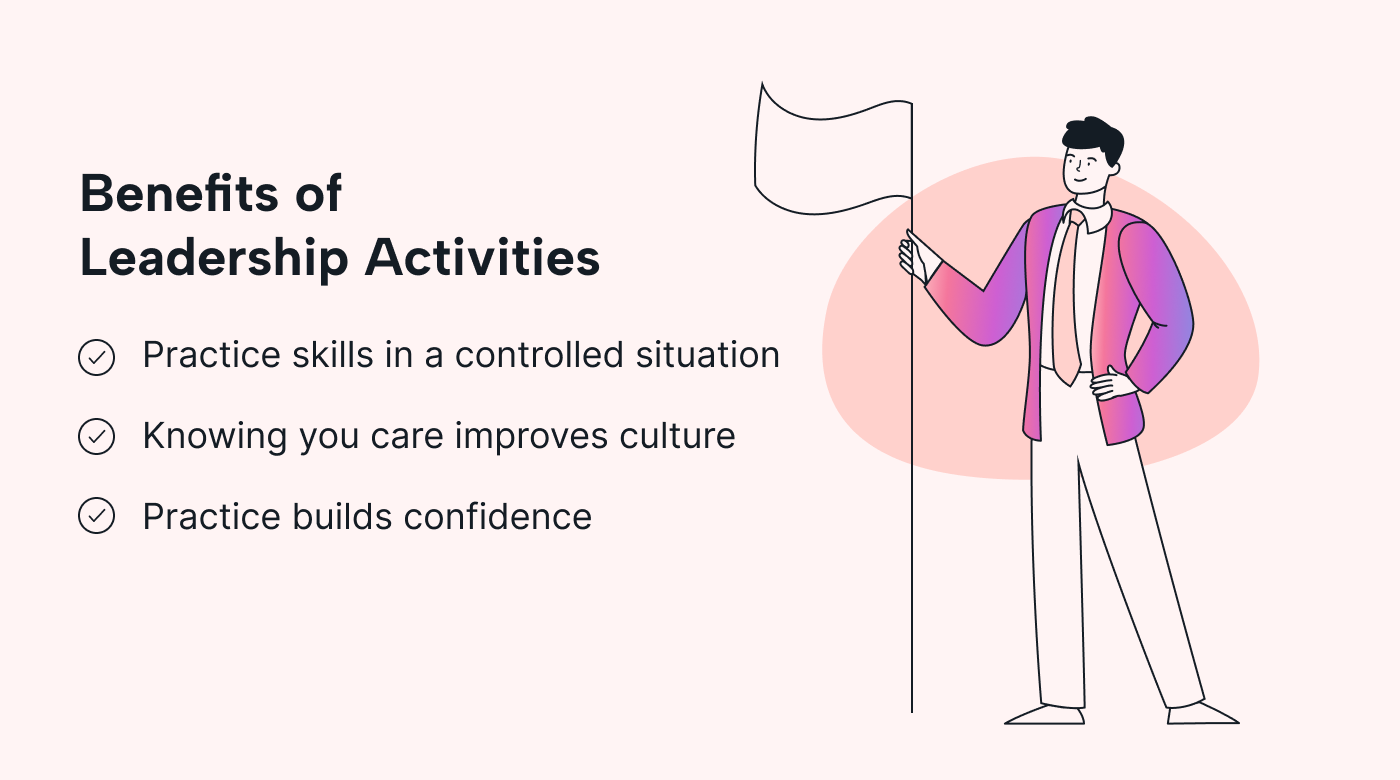Leaders can make or break a work environment.
No one likes to report to a bad leader. Leaders need to develop skills just like everyone else to be good at their job. So, what are you doing to develop leadership skills in your organization?
If you don't have an answer, have you considered implementing leadership activities?
In this article, we will discuss:
- What are leadership activities?
- Benefits of leadership activities
- Types of leadership activities
- Scheduling leadership activities in Motion
What are leadership activities?
Leadership activities are an effective way for leaders to develop the skills they need to be influential leaders. Just like athletes need to practice before games, successful leaders need to practice their skills for the work environment.
Leadership activities can be done with anyone, from children to adults, but for this article, we will focus on leadership activities for the workplace. They can be done as a part of a leadership development program or simply from time to time to brush up on skills.
Benefits of leadership activities
If you give your leaders time to develop their skills, you’ll see many benefits. Let’s take a look at a few.
Practice skills in a controlled situation
Leaders deal with many issues that can be stressful: employee performance issues, making big decisions that are time-sensitive, and dealing with conflicts between employees, to name a few.
Leadership games allow them to test skills safely rather than “practicing” in real life where a mistake directly impacts employees.
Consider decision-making as an example. If an IT manager has to decide what development environment to purchase, the wrong choice makes life more challenging for the programmers. If the server isn’t powerful enough to run compiles efficiently, developers will be wasting a lot of time waiting for the code to be ready to try out. At the same time, the IT manager doesn’t have an unlimited budget.
If the manager doesn’t practice making decisions, it’s easier to make a bad decision. If they practice making decisions in an activity, they can develop the skills to make these critical decisions more confidently.
Knowing you care improves culture
If you hire a new employee, you will likely train them on your business practices and the industry they are working in. It’s expected that new employees need time to get up to speed.
Even if a manager has been at your company for years, they will need time to adjust to their management role, no matter how good they were at their previous position. If you just throw employees into management and don’t help them learn how to lead, they will probably struggle. Providing leadership exercises sends the message to your leaders that you care about their development and want to help them succeed.
Prospective leaders in the organization who may be working towards a management position will also see that they will have support when they reach a management role.
Practice builds confidence
When given the chance to practice skills, confidence builds. A baseball team would not send a pitcher to the mound without having them pitch to players during practice, right? Their confidence grows as the pitcher tries out different pitches before their actual scheduled games. They see what pitches work for earning strikes against the batter.
The same holds true for practicing leadership qualities. If a leader gets the chance to practice different skills, they can see what techniques work – and which ones don’t – before they get into situations that count. Employees will appreciate not being the guinea pig of a leader who has never had any practice.
 |
Types of leadership activities
Let’s take a look at some types of leadership development activities that help develop necessary skills.
Decision-making leadership activities
Good leaders get the input they need from their project teams and make informed decisions.
Leaders who make poor decisions without getting the information they need negatively impact their team. A wrong decision can impact morale and hinder productivity.
1. Dot voting
One example of a decision-making leadership activity is dot voting. To practice dot voting, participants can vote on a list of ideas. Let’s pretend, as a hypothetical situation, the team is given a scenario where they need to determine which training would benefit their team. The training options include:
- Time management.
- Making meetings productive.
- Being an empathetic leader.
- HR policies and procedures.
Team members are given a set number of dots. We’ll use five in our example. At voting time, the team members put their dots on the option(s) they like best. The training option with the most dots will be considered the winner for the first round of training.
Leaders can implement this practice with their own teams to get input from employees.
2. Level of influence
A second example of a decision-making leadership activity is the level of influence. Level of influence involves ranking the level of influence a team has to make possible actions happen. The team then focuses their energy on the tasks that they have the most influence on, where they can make a real difference.
 |
Team building leadership activities
Leaders influence how teams work together. When leaders practice team-building games, they can use these with their own team to help build good working relationships.
3. Human knot
An example of a team-building activity is the human knot. Team members randomly select two other hands to hold with their eyes closed. When everyone opens their eyes, they must figure out how to untangle the knot without letting go of each other’s hands.
4. Tower building
A second example is building towers using marshmallows and uncooked pasta. This is a fun activity where teams compete to build the tallest tower. Since they have to strategize together, the team builds itself while they build the tallest structure.
 |
Trust and collaboration activities
Leaders need to establish trust with their employees. Employees need to be able to trust their manager’s decisions and feel comfortable bringing up concerns to them. Team members also need to be able to trust each other. Teams that can count on other members to get their work done and support each other will work better together.
Leaders also need to collaborate with their teams. Getting input from everyone in a group helps the team function better, and leaders make better decisions. Team members also need to collaborate on tasks.
5. Tower of power
Tower of Power is an example of a leadership activity that helps build trust and collaboration. Teams are asked to build a tower using specific rules. They then reflect on what went well and what could be improved the next time they attempt this activity. This reflection practice can be carried over into projects. For example, sprint retrospectives involve reflecting on what went right and what needs to be improved for future sprints.
6. Minefield
A second example of a trust and collaboration leadership activity is Minefield. Participants are paired up. One member of the team is blindfolded. A “minefield” with obstacles is set up. The second team member must guide their team through the Minefield with instructions to keep them from hitting an obstacle. While a project team isn’t likely to encounter any actual minefields, practicing trusting others to guide them can build team trust.
Team conflict leadership activities
All teams experience conflict from time to time. Team members might disagree on a decision or assignment or not get along with someone with a different personality. Leaders are responsible for helping to resolve conflicts. Conflicts are usually stressful, so knowing how to handle them is essential before you experience a conflict.
7. What, so what, now what?
An example of a team conflict leadership activity is “What, so what, now what?” This activity involves the group collecting facts about a conflict. Everyone in the group should be allowed to speak about the conflict. After everyone speaks, the team can suggest how to move on from the conflict.
8. Bright blurry blind
A second example of a team conflict leadership activity is “Bright Blurry Blind.”
Team members are given three cards used to classify issues.
One represents “bright” - which means an issue that is out in the open. Everyone knows about this concern. An example might be when a key employee has resigned. Everyone knows about the issue and is concerned about how the gaps of this person leaving will be filled.
The second card represents “blurry”. Blurry is a conflict that is known but not spoken about enough. An example might be if a company seems to be having financial trouble. Employees are aware of the issue by things they see going on, such as expenses being cut. However, they may feel uncomfortable talking about it. If this conflict were to become bright, the organization could inform the employees about what they are doing to solve financial issues, such as recruiting new customers.
The third card represents “blind”. A team struggles with these issues that they feel no one else is aware of. An example might be a network services department in a large organization that feels overwhelmed by IT-related requests from the entire organization. They might be dealing with users who are upset their requests are not completed as fast as they would like - but the users don’t realize that they have a queue of hundreds of requests. Blind issues need to be brought out into the open; otherwise, how would they be addressed?
 |
Communication leadership activities
Leaders need to have excellent communication skills. They must communicate effectively with their team and stakeholders and encourage communication.
9. Active listening
Active listening is one example. The first step in active listening involves being fully present when listening to another person.
Have you ever been in a meeting with someone on their phone, texting, or checking email, then asked a question that has already been answered? Everyone paying attention in the meeting gets frustrated that their time is being wasted.
The same is true with a leader who doesn’t listen to their employees. If an employee has to repeat themselves because the leader doesn’t pay attention, and they don’t feel their input is valued, they will likely give up on trying to communicate with them. Team leaders who listen actively are more likely to get valuable constructive feedback.
After receiving the information, the next step is understanding what is said. If something is unclear, the information receiver should ask questions to ensure they understand everything.
Next, the listener should evaluate the information and form an opinion.
After evaluating, the listener needs to remember the information and then respond. When you truly listen to another person, you are more likely to respond well to what they say.
10. Trust battery
Another example of a communication listening activity is a trust battery. Trust battery involves allowing team members to reflect on their level of trust with others they work with. The activity measures the levels in percentages, like a battery charge level. Participant A may say they are at a 90% trust or charge level with Participant B. Participant A may evaluate their trust level as 40% with Participant C.
Participants should evaluate what they can do to improve their trust level with team members with lower trust levels. For example, would improving communication help?
Leaders can use this activity on their teams to see how much trust exists within the team and evaluate ways to improve trust among everyone.
Schedule leadership activities in Motion
These important activities will likely get overlooked if you don’t schedule leadership exercises into your leaders’ schedules. Consider using Motion’s Intelligent Calendar to schedule leadership activities among your employees’ other tasks to ensure they spend time on leadership development.
If you want better leaders (and to be one yourself), give yourself and your team time to focus on building their skills. Motion will find time on everyone’s schedules to make your leadership activities happen.
If you aren’t already using Motion, access a free trial today.





